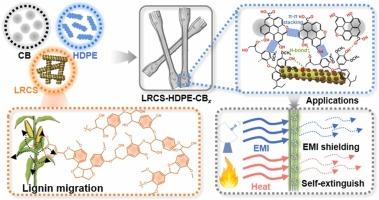用于电磁屏蔽和阻燃的原位木质素改性玉米秸秆/聚乙烯/炭黑复合材料
IF 6.2
1区 农林科学
Q1 AGRICULTURAL ENGINEERING
引用次数: 0
摘要
木塑复合材料(WPCs)的功能化是绿色建筑和汽车工业领域的一大需求。然而,如何在聚合物基体中更好地分布功能成分仍然是一项具有挑战性的工作。本文通过原位木质素再生策略构建了一种新型导电玉米秸秆/聚乙烯/炭黑复合材料,在此过程中,玉米秸秆(CS)中的木质素迁移到纤维表面,并通过调节 CS 的极性优化了各组分之间的界面相容性。原位木质素改性 CS 促进了导电炭黑(CB)在高密度聚乙烯(HDPE)基体中的均匀分布,从而使 LRCS-HDPE-CBx 复合材料具有优异的导电性(12.94 S/m)和机械性能(例如与未改性的 CS-HDPE-CBx 复合材料相比,LRCS-HDPE-CBx 复合材料具有更高的电导率(12.94 S/m)、机械性能(例如,LRCS-HDPE-CB30 的拉伸强度为 29.05 MPa)、热稳定性以及良好的电磁干扰屏蔽效果(24.00 dB,8.2-12.4 GHz)和自熄灭能力(极限氧指数为 23.5%)。因此,这项工作为制造导电木塑复合材料提供了一种简单可行的方法,这种复合材料具有均匀的成分分布和良好的功能性。本文章由计算机程序翻译,如有差异,请以英文原文为准。

In-situ lignin modified corn straw/polyethylene/carbon black composites for electromagnetic shielding and inflaming retarding
The functionalization of wood-plastic composites (WPCs) represents a significant demand in the fields of green building and the automotive industry. However, the superior distribution of functional components within the polymer matrix remains a challenging endeavor. In this paper, a novel conductive corn straw/polyethylene/ carbon black composite was constructed through an in-situ lignin regeneration strategy, during which the lignin in corn straw (CS) migrated to the surfaces of fibers and the interfacial compatibility among each component was optimized through the polarity modulating of CS. The in-situ lignin modified CS promoted the uniform distribution of conductive carbon black (CB) in the high-density polyethylene (HDPE) matrix, and resulted in LRCS-HDPE-CBx composites with superior conductivity (12.94 S/m), mechanical properties (e.g., a tensile strength of ∼29.05 MPa for LRCS-HDPE-CB30), thermal stability, as well as promising EMI shielding effectiveness (∼24.00 dB, 8.2–12.4 GHz) and self-extinguishing capability (a limiting oxygen index of 23.5 %) when compared to unmodified CS-HDPE-CBx composites. Thus, this work provides a simple and viable method for the fabrication of conductive wood-plastic composites exhibiting a uniform compositional distribution and promising functionality.
求助全文
通过发布文献求助,成功后即可免费获取论文全文。
去求助
来源期刊

Industrial Crops and Products
农林科学-农业工程
CiteScore
9.50
自引率
8.50%
发文量
1518
审稿时长
43 days
期刊介绍:
Industrial Crops and Products is an International Journal publishing academic and industrial research on industrial (defined as non-food/non-feed) crops and products. Papers concern both crop-oriented and bio-based materials from crops-oriented research, and should be of interest to an international audience, hypothesis driven, and where comparisons are made statistics performed.
 求助内容:
求助内容: 应助结果提醒方式:
应助结果提醒方式:


